New Book Releases / Spring + Summer 2022
If you would like to alert us to a recent or forthcoming film publication for the next round-up in winter, please contact us here. For notes on more books, see David Hudson’s monthly round-up at Criterion’s The Daily.
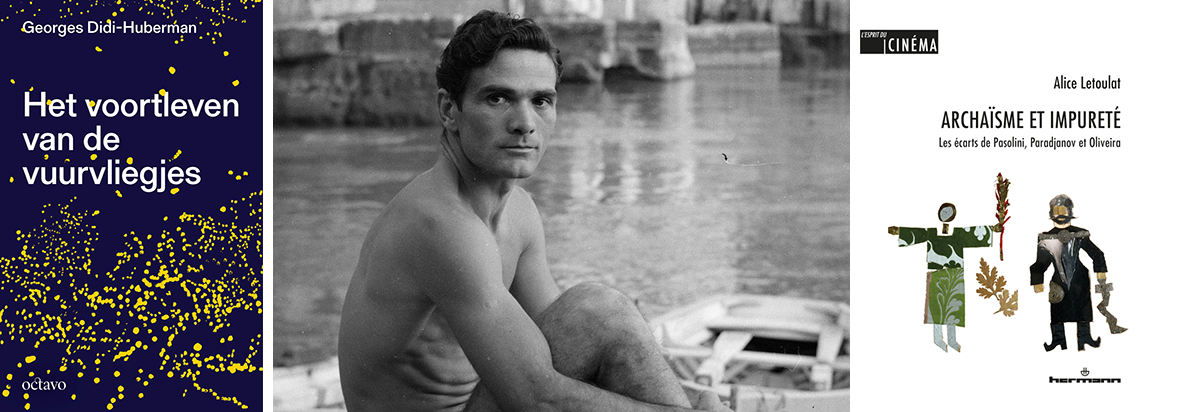
Late spring can be beautiful as one Japanese director showed us. Since our last winter book wrap was published on Christmas Eve, this is a round-up of worthwile film publications of 2022 so far. Let us first go back to the month of March: Pier Paolo Pasolini was born 100 years ago this year and the world will have known. As publishers are joining in the celebrations and a seemingly endless stream of new books is dedicated to the Italian filmmaker and poet, we are well aware that we’ll never be done with Pasolini. Starting off with two fireflies themed publications to be released this fall, Amsterdam-based publisher Octavo will publish a translation of Georges Didi-Huberman’s Survivance des lucioles (Les Editions de Minuit, 2009), which responded to Pasolini’s words on the appearance of the fireflies under Mussolini’s searchlights and the disappearance of the fireflies in the bright light of the society of the spectacle. The book will be published under the Dutch title Het voortleven van de vuurvliegjes, with a new afterword by art critic Pieter Van Bogaert.
Pasolini’s text on the fireflies was the inspiration for the Fireflies film magazine and the accompanying publishing house Fireflies Press. We are very much looking forward to their Pier Paolo Pasolini: Writing on Burning Paper that’s already available for pre-order. The book will feature Pasolini’s epic autobiographical poem “Poeta delle ceneri” in a revised translation by poet Stephen Sartarelli alongside original written and visual tributes by contemporary filmmakers such as Radu Jude, Angela Schanelec, Jia Zhangke or Basma Alsharif.
Pasolini is also one of the three filmmakers brought together in Archaïsme et impureté: Les écarts de Pasolini, Paradjanov et Oliveira, published earlier this year. Alice Letoulat looks at Pasolini’s films alongside the cinema of Manoel de Oliveira and Sergei Paradjanov via their filmic gestures and aesthetic postures.
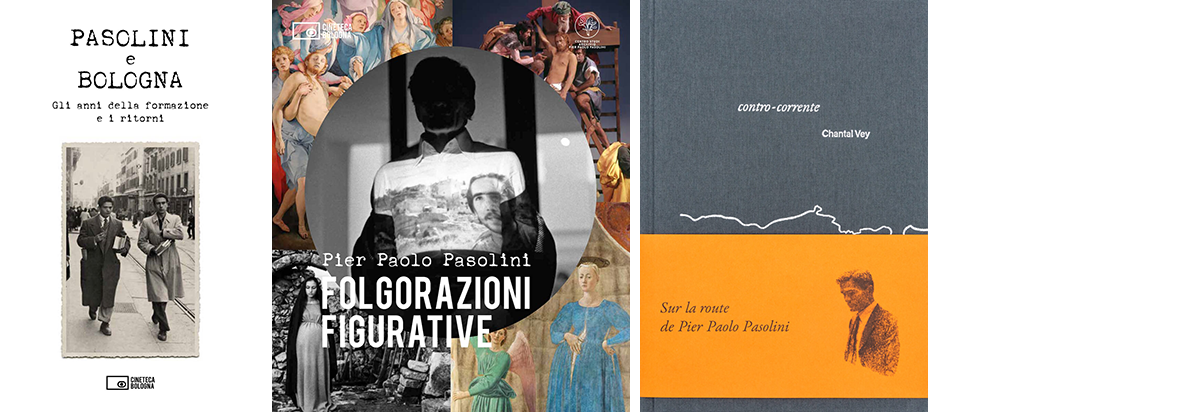
Last time we checked, the Italian Amazon website listed no less than 73 Pasolini publications, reissues or translations for 2022 alone. We single out the two Italian-language Pasolini books published by the Cineteca di Bologna, both released on March 10. Pasolini e Bologna focuses on the filmmaker’s relationship with the city where he was born and underwent his education. Next to a number of key essays, the book also contains a wide selection of Pasolini’s own early texts, including writings relating to frequent returns to his hometown. Pier Paolo Pasolini. Folgorazioni figurative is the catalogue accompanying the homonymous exhibition still running until October 16. Both publications share a particular attention for Roberto Longhi, the world-renowned Quattrocento specialist who was Pasolini’s professor in Bologna. Each Pasolini film is reviewed with the eye turned to these “figurative shocks” (“folgorazioni figurative”) he experienced at the time of his training.
Also linked to an exhibition is the bilingual (FR/IT) publication Contro-Corrente: Sur la route de Pier Paolo Pasolini for which Brussels-based French visual artist Chantal Vey travelled the reverse road that Pasolini describes in La lunga strada di sabbia, his wide report commissioned by the magazine Successo on the state of Italy in 1959. The publication is also on sale at the reception of the Brussels' CINEMATEK, where the exhibition ran until the end of April.
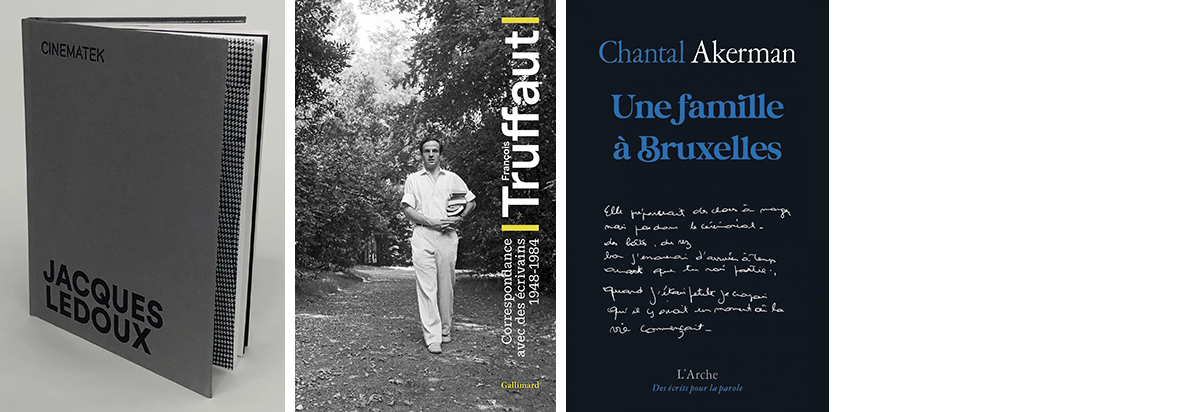
The first curator of the latter institution, Jacques Ledoux, has been celebrated with a trilingual publication on the occasion of yet another centenary. Launched by CINEMATEK as a limited edition in the beginning of the year, this book contains exclusive material about the film archivist who made the Royal Belgian Film Archive an internationally renowned institute. Jacques Ledoux brings together testimonies collected by Christophe Piette from film historians such as Bernard Eisenschitz or Kristin Thompson and David Bordwell, who also reviewed the book. Eric De Kuyper and P. Adams Sitney offer illuminating appreciations of Ledoux, but perhaps the most personal contribution comes from Gabrielle Claes, who was Ledoux’ right hand and eventually became his successor. She gives us a glimpse of the man behind the myth, beyond the mystery that surrounded him. The book also includes an unpublished interview with Ledoux and his correspondence with Jean Cocteau and Chantal Akerman, among others.
François Truffaut, who regularly visited Ledoux at the Royal Film Archive, also sent his first letter to Cocteau as a young teenage cinephile and they would eventually become like family. This letter and the many other ones Truffaut exchanged with notable writers and literary figures (Jean Genet, Jean Cayrol, ...) are now brought together in François Truffaut: Correspondance avec des écrivains, 1948-1984, published by Gallimard last March. Another important filmmaker-friend of Ledoux was Chantal Akerman, whose text Une famille à Bruxelles, first published in 1998, was reissued in February by L’Arche. Inspired by the death of her father, Akerman explores mourning, remembrance and forgetting in an interior monologue between autobiography and fiction. Hanns Zischler, the actor who plays Hans in Akerman’s Les Rendez-vous d’Anna (1978), wrote the afterword for this new edition.
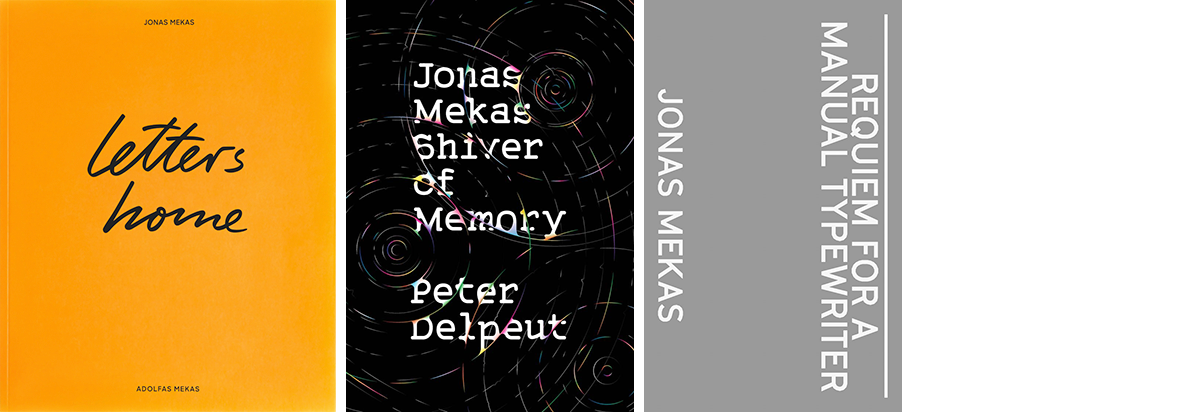
We also find a very Akermanian title in the first of three new Jonas Mekas books. Letters Home is a collection of unedited handwritten letters the filmmaker and his brother Adolfas Mekas sent from America to their mother in Lithuania religiously throughout the decades. Published by Passport in a limited edition, the book shows the ability of the dying art of letter writing to bridge emotional, geopolitical and cultural distances, while at the same time being a way of memory-making.
Memory and Mekas’ past in his homecountry are also what’s at stake in Jonas Mekas: Shiver of Memory, the English translation with DoppelHouse Press of Het vergeten kwaad: De herinneringen van Jonas Mekas (Atlas Contact, 2021) which we reported on in our winter book wrap of 2021. Carrying a lifelong admiration for Mekas, the Dutch author and filmmaker Peter Delpeut investigates the claim of historian Michael Casper, put forward in The New York Review of Books of June 2018, that Mekas knowingly forgot or misrepresented certain events that happened in Lithuania during Word War II, the country he fled for the States in 1949. Delpeut’s research resulted in a personal essay on historiography versus individual memory, in which he did not want to go easy on Mekas, Casper or himself.
Many of Jonas Mekas’ letters to his mother and friends, but also his diaries, poems, Movie Journal columns, interviews and manifestos were typed with two index fingers on his beloved Olympia De Lux typewriter. On 25 March 1997, Mekas found a dusty roll of computer paper under his desk and he began to write a text on it that was quite unusual for him: a novel. Requiem for a Manual Typewriter is a hymn of praise to his Olympia De Luxe, which he uses to practise writing in the moment, describing the present on a machine that was already considered technologically outdated. Forthcoming in English this fall with Spector Books, this text, which Mekas also performed as a lecture, appears for the first time as a book, presented with 14 photographs by Andrzej Steinbach.
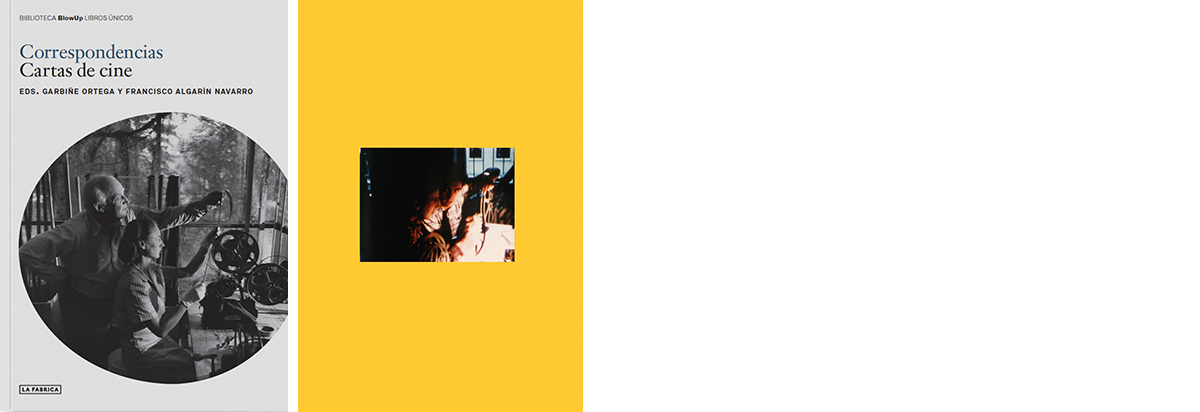
Fifty letters, including one of Stan Brakhage to Jonas Mekas, are also what we find in a new edition of Correspondencias: Cartas de cine that appeared at La Fabrica. This Spanish-language volume contains letters between Jean Cocteau & Jean Marais, François Truffaut & Jean Renoir, Marguerite Duras & Alain Resnais, or correspondence with/from PIer Paolo Pasolini, Charlie Chaplin, Carolee Schneemann, Sergei Eisenstein, Jean-Luc Godard, Luis Buñuel, and so on. These were orginally brought together by the experts Garbiñe Ortega and Francisco Algarín Navarro for the 12th edition of the International Documentary Film Festival Punto de Vista.
Another book edited by Francisco Algarín Navarro, in this case together with Carlos Saldaña, is Horas iluminadas: Nathaniel Dorsky y Jerome Hiler. In our previous book note, we highlighted Lumière’s reissue of Nathaniel Dorsky’s Devotional Cinema, but somehow failed to mention this accompanying Spanish-language publication. It’s the first book about these filmmakers that covers more than 40 years of work and shared life, including four new interviews, texts from the filmmakers and friends of the couple, documents, manuscripts, letters (Brakhage and Mekas again), notes and personal photos. It’s Lumière’s first book printed in offset and full color.
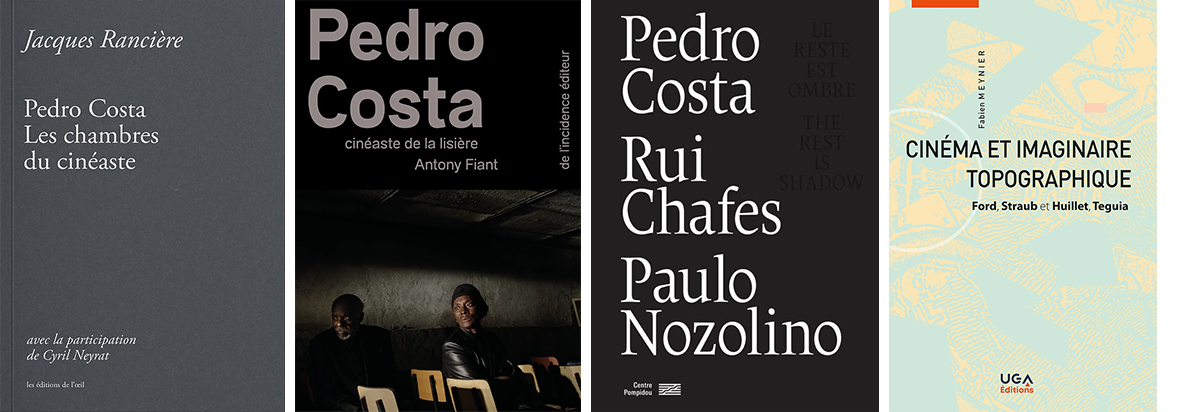
This month, Pedro Costa takes in Paris. Between the 14th and 26th of June, Jeu de Paume sets up a retrospective of his work together with a carte blanche program by Costa. From June 8 to August 22, the filmmaker is part of Centre Pompidou’s group exhibition ‘Le Reste est ombre’, dedicated to Portuguese artists Pedro Costa, Rui Chafes and Paulo Nozolino. Set up around the installation As filhas do Fogo by Costa and Chafes, the former’s film Minino macho, Minino fêmea, and accompanied by a series of photographs by Paulo Nozolino, the exhibition is presented in the form of a renewed dialogue between film, sculpture and photography. The catalogue which will be out at the end of this month is available for pre-order.
You can prep for the exhibition or film program with two new books on Pedro Costa appearing this month. Published by De l’incidence éditeur, Antony Fiant’s Pedro Costa, cinéaste de la lisière approaches him as a “filmmaker of the margin”, interpreting Costa’s oeuvre as an attempt to bring back into focus those who are usually confined to the edge of the world. Antony Fiant is the author of Wang Bing, un geste documentaire de notre temps (WARM, 2019), the co-coordinator of the two volumes of Les Variations Hong Sang-soo and he collaborated with Trafic and Positif. The other book, Pedro Costa – Les chambres du cinéaste first brings together five texts by Jacques Rancière on Costa’s cinema, then conversations between the philosopher and critic Cyril Neyrat around selected moments from the filmmaker’s work, and finally, three public discussions between Rancière and Costa that took place in Madrid, Barcelona and Lille. His 2011 text “Politique de Pedro Costa”, included in the collection, is available on Sabzian in a Dutch translation, next to many other texts by and conversations with Rancière. As reported in our previous book wrap, Cyril Neyrat also just co-edited Matériaux – Pedro Costa last January for the same publisher, Editions de l’oeil. The title of this new collection derives from Rancière's essay on Costa's ‘poetics of the room’ in Where Does Your Hidden Smile Lie? (2001) and In Vanda's Room (2000).
“Akerman and Warhol and Straub-Huillet and Godard and others... Everything has its place in my filmhouse. Actually, it’s exactly like a house. It has the foundations that I cannot avoid – the Chaplins, the Fords, the Ozus and the Mizoguchis. Then you can go into the rooms.” Pedro Costa once described his cinematic reference points in this spatial way, where John Ford, Jean-Marie Straub & Danièle Huillet take in important chambers. Forthcoming in September, Cinéma et imaginaire topographique: Ford, Straub-Huillet, Teguia unites these three oeuvres around the concept of place. Offering a fresh perspective on these well-known filmmakers, the book shows how their films articulate a “topographic imaginary” by inventing new images of the places they record while at the same time going back to certain iconographic traditions.
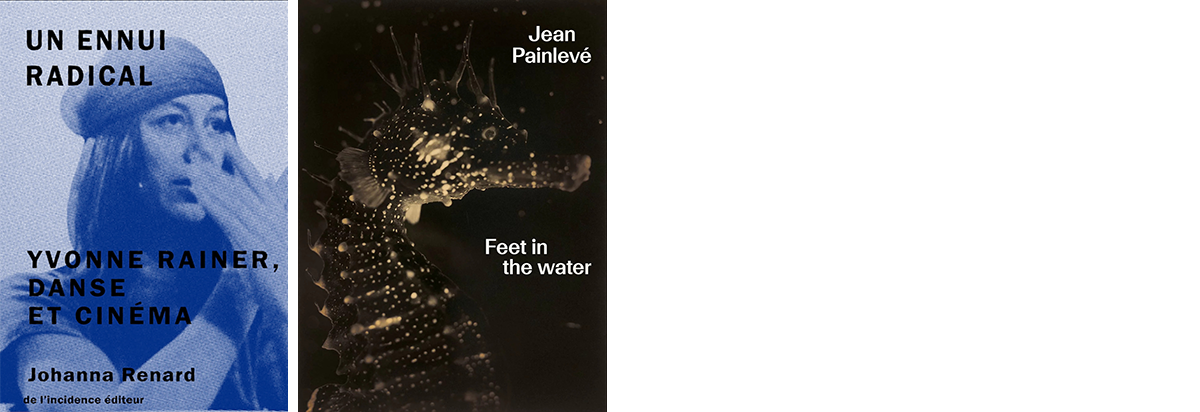
De l’incidence éditeur not only comes with the new Pedro Costa publication, but also releases a book on choreographer and experimental filmmaker Yvonne Rainer by the end of the summer. In Un ennui radical: Yvonne Rainer, danse et cinema, Johanna Renard offers a well-documented analysis of Rainer’s performances and films through the prism of one particular emotion: boredom. Drawing on the philosophy of emotion and queer and feminist theory, Renard reveals Rainer’s relationship to boredom as inherently political.
A whole other type of (underwater) dance can be seen at Jeu de Paume which, next to Costa’s retrospective, organizes the first large-scale exhibition in France devoted to pioneering filmmaker Jean Painlevé. While the exhibition – which runs from June 8 to September 18 – will show some twenty black and white and color films, both silent and sound, as well as a hundred photographs and documents, the catalogue, Jean Painlevé: Feet in the Water, brings together a number of texts on Painlevé, who combined his two passions, marine biology and cinematographic techniques, by capturing the movements of aquatic fauna in his avant-garde work. Edited by film historian and curator Pia Viewing and published by Lienart, the catalogue will appear in June in both French and English.
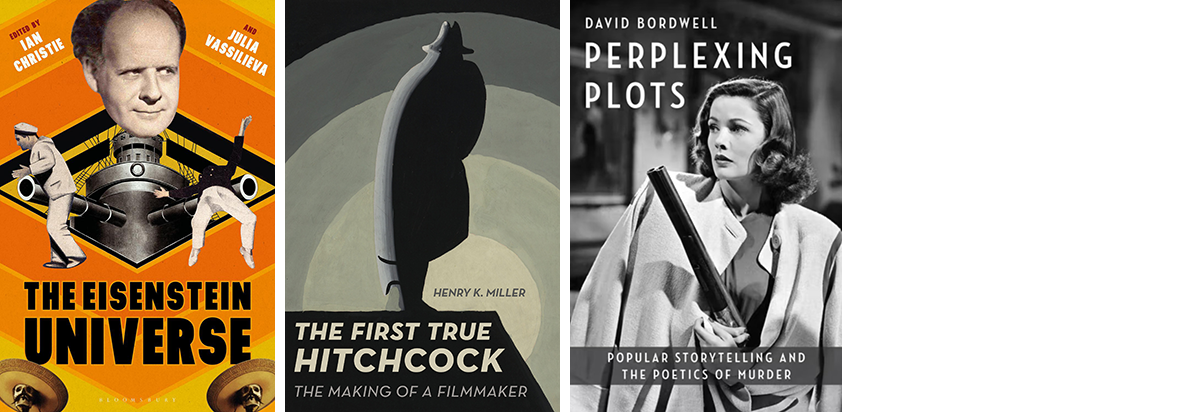
A next pair of books casts new light on two film giants of which one wonders what new things could possibly remain to be said. Using fresh archival discoveries, The First True Hitchcock: The Making of a Filmmaker focuses on The Lodger (1927) and the twelve-month period between its production and release to present a new picture of this pivotal year in Hitchcock’s life and in the wider film world, but above all to tell the untold origin story of how Hitchcock became Hitchcock.
The Eisenstein Universe opts for an opposite approach and doesn’t try to reveal “the true Eisenstein”. In their introduction “Eisenstein Unbound” – available on the website of publisher Bloomsbury – editors Ian Christie and Julia Vassilieva write: "Eisenstein has become, we suggest, a universe of possibilities. [R]ather than try to synthesize [all new material] into yet another ‘new Eisenstein’, we have chosen to let it point in different directions. (...) There are now many more Eisensteins to choose between, or to contemplate, as the sixteen international scholars represented here demonstrate in their contributions.”
Alfred Hitchcock is also one of the directors whose plot engeneerings are explored in the new and upcoming book of David Bordwell – nota bene an Eisenstein expert too as author of The Cinema of Eisenstein (1993/2005). Only set for January next year with Columbia University Press, Perplexing Plots: Popular Storytelling and the Poetics of Murder asks when and how forms and styles once regarded as “difficult” became familiar to audiences. On his blog, Bordwell adds that the new book is complementary to his previous one in the way that it turns Reinventing Hollywood inside out. The earlier one showed how films borrowed from mysteries in other media, while the new one discusses how mystery conventions developped in other media such as fiction, theatre, radio or comics and then showed up in films as well. And as you've probably heard last month, David Bordwell and Kristin Thompson have made some of their books available to download for free from now on.
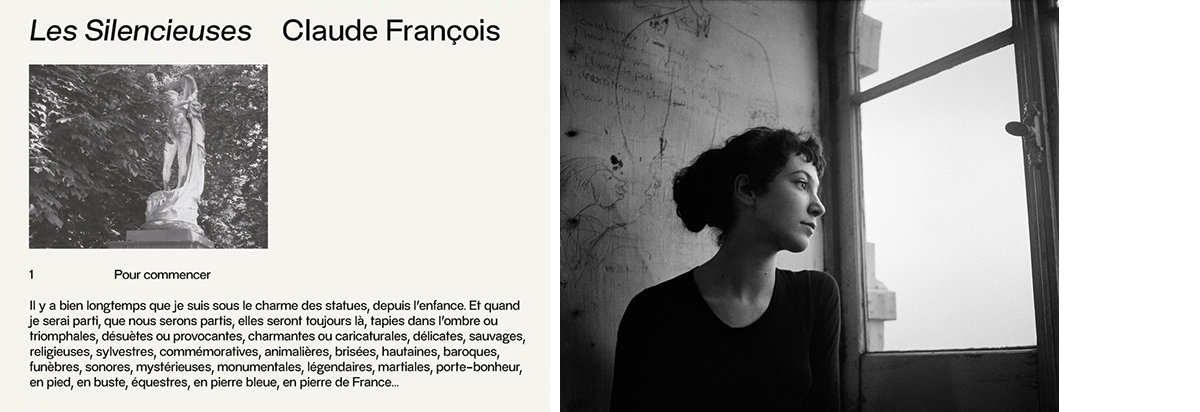
The Dutch photographer-filmmaker Johan van der Keuken will be the subject of a large exhibition in the Nederlands Fotomuseum in Rotterdam from October 7 until February next year. Since a few years, the museum manages his photographic archive and they are preparing a publication that will accompany the exhibition. Flagey in Brussels just ended its run of screenings in tribute to Claude François, not the singer but the Belgian director and cameraman who passed away one and half year ago and is now honored with a publication by the Brussels publishing house CFC-Éditions. Trained at La Cambre in Brussels, François is most renowned for his art documentaries. Les Silencieuses: Claude François takes the form of a storyboard based on his last film, Silencieuses (2021), a playful ode to the statues that, scattered around Brussels, captured his attention as a kid.
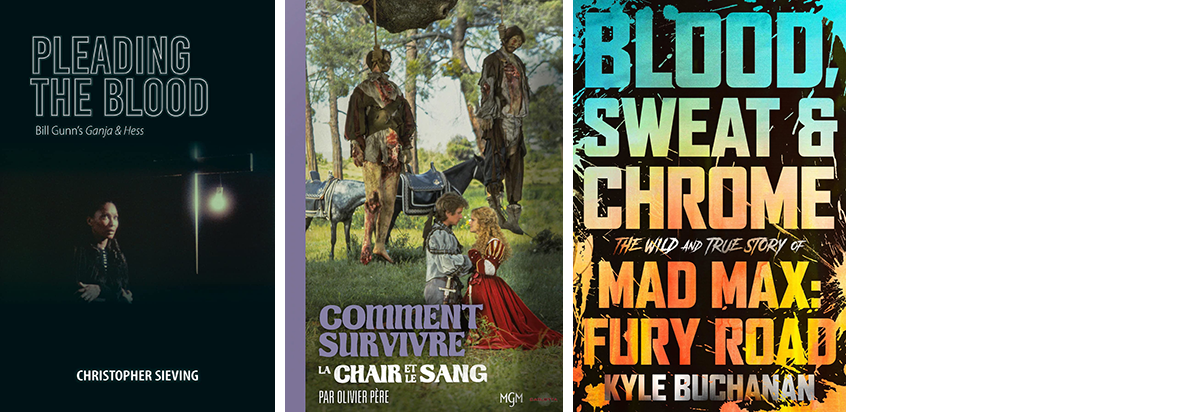
The next trio of blood-related monographs also focus on one film. Pleading the Blood: Bill Gunn’s Ganja & Hess is the first full-length study of this 1973 landmark feature of African-American cinema. Drawing on Bill Gunn’s archived papers, screenplay drafts and storyboards, as well as interviews with the living major creative participants, the book offers a comprehensive and absorbing account of the film’s poetic re-fashioning of the vampire genre into a languid, baroque and phantasmagoric exploration of addiction, assimilation and identity.
Carlotta’s new blu-ray box set with the restoration of Paul Verhoeven’s deromantized, immoral and filthy medieval fantasy Flesh + Blood (1985) contains a 160-page book written by Olivier Père, including 40 archive and set photos. In this unpublished text, Comment survivre: La chair et le sang, Père argues that the question of survival is at the very heart of Flesh + Blood: it applies to all its heroes, but also to Verhoeven himself for whom this film was a lesson in artistic survival.
It’s also a miracle anybody survived the nearly two-decade making and shooting of Max Max: Fury Road (2015). In the already much-discussed Blood, Sweat & Chrome, The New York Times’ Kyle Buchanan tells the story in vivid detail with more than 130 new interviews, dubbed “a deft and rollicking assembly” by Nicolas Rapold, former editor of Film Comment. Meanwhile, the Australian shoot of the film’s spin-off and prequel, Furiosa (2024), has started this month.
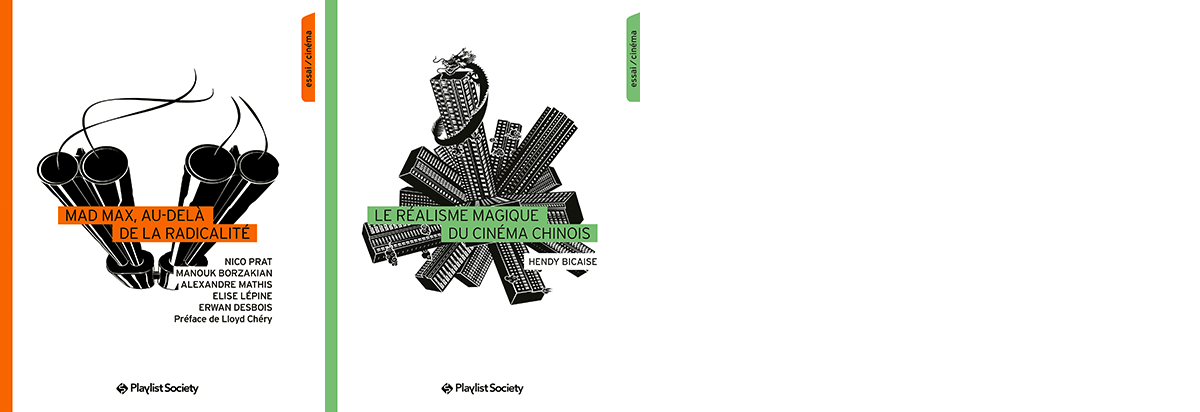
Also published earlier this year, Mad Max, au-delà de la radicalité is a book-length essay in which five members of the Playlist Society collective analyse the whole saga. It’s a good occasion to highlight this interesting publishing house in Nanterre. Last April, Playlist Society also pubished Le Réalisme magique du cinéma chinois that focuses on the new, sixth generation of Chinese filmmakers, with much attention for director Bi Gan and his major work Kaili Blues (2015).
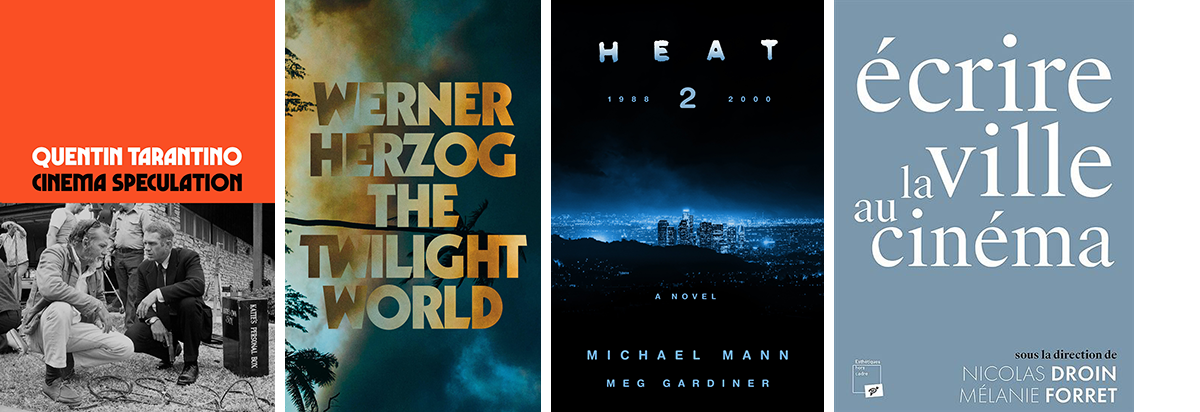
While Quentin Tarantino presents his first nonfiction book, three other directors – Werner Herzog, Hal Hartley and Michael Mann – come with their debut novel. Organized around key American films from the 1970s, Cinema Speculation is scheduled for October and will be at once film criticism, film theory, a feat of reporting and a personal history.
Out this month, Werner Herzog’s The Twilight World immortalizes the true story of Hiroo Onoda, a Japanese soldier who quixotically defended a small island in the Philippines for nearly three decades after World War II had ended, unaware the fighting was over. Herzog already met Onoda in 1997; they developed an instant rapport and would meet many times, talking for hours and together unraveling Onoda’s story. Originally published as Das Dämmern der Welt in August last year, the novel has now been translated for Penguin Press.
Key filmmaker of the American independent film movement of the 80s and 90s, Hal Hartley, comes with a first novel about a cloister run by a gang of outlaw nuns who open a microbrewery and market their specialty craft beer to the affluent hipsters of Williamsburg… Our Lady of the Highway is out with Elboro Press, the publishing company Hartley started himself last year to produce the books of his screenplays and other writing. The paperback is a novelization of a TV series he wrote but never produced.
Forthcoming in August, Heat 2 is described by Michael Mann as both a prequel and sequel to his iconic film of the same name. Co-written with Meg Gardiner, the bestselling author of California-set thrillers and crime novels, this 480-page(!), all-new story illuminates what happened before and after Heat (1995). Mann recently said: “I plan to go beyond the 2002 ending of Heat 2. I definitely plan on taking the story further...”
Some of Michael Mann’s other work, Collateral (2004) and Miami Vice (2006), is discussed in a separate chapter in a new collection. Published last month, Ecrire la ville au cinéma explores how filmmakers show and use the city. It’s a rather academic publication, but includes several interesting cases, such as Suzanne Liandrat-Guigues’ contribution on Les mains negatives (1979), Prosper Hillairet on Le Samouraï (1967), an interview with Sylvain George, and chapters on Guy Gilles, Leos Carax and Hugo Santiago.
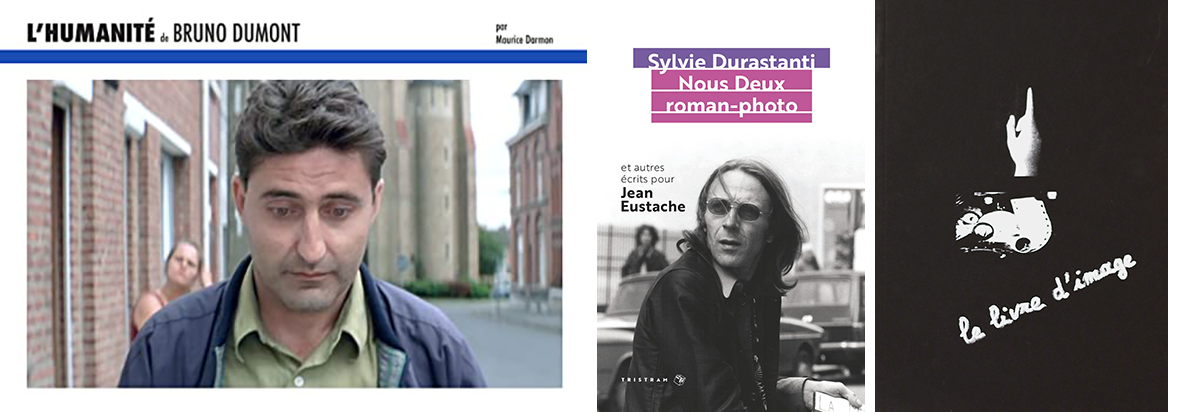
The next volume in Yellow Now’s excellent series of monographs on a single film will be on Bruno Dumont’s L’Humanité (1999). Writen by Maurice Darmon, the booklet will be out in October and also include Dumont’s script draft and his shooting notes.
Earlier this year, Jean-Luc Godard also put out two facsimile editions of the handmade script of Le livre d’image (2018). One of the first screenplay version of the film when it was originally called Le grand tableau (noir), and one of the manuscript of Le livre d’image. The former contains the raw material, the books, images and music that make up the film; the latter also gathers the spoken texts in French and English. Both editions are bilingual, limited to 1500 copies and numbered by hand.
More screenplays. Last April, two unfilmed scripts written for Jean Eustache by his last partner Sylvie Durastanti have been published. She wrote three films for him, of which only Offre d’emploi (1980) could be realised. He was preparing the shoot of the other ones, “Un moment d’absence” and “Nous Deux roman-photo”, before his death in 1981. Next to these two scripts, Nous Deux roman-photo – Et autres écrits pour Jean Eustache contains a third part with a text of Durastanti about the particular circumstances of her work for Eustache. Meanwhile, the restoration of La maman et la putain (1973) is playing in French theaters since June 8 and touring around the world.
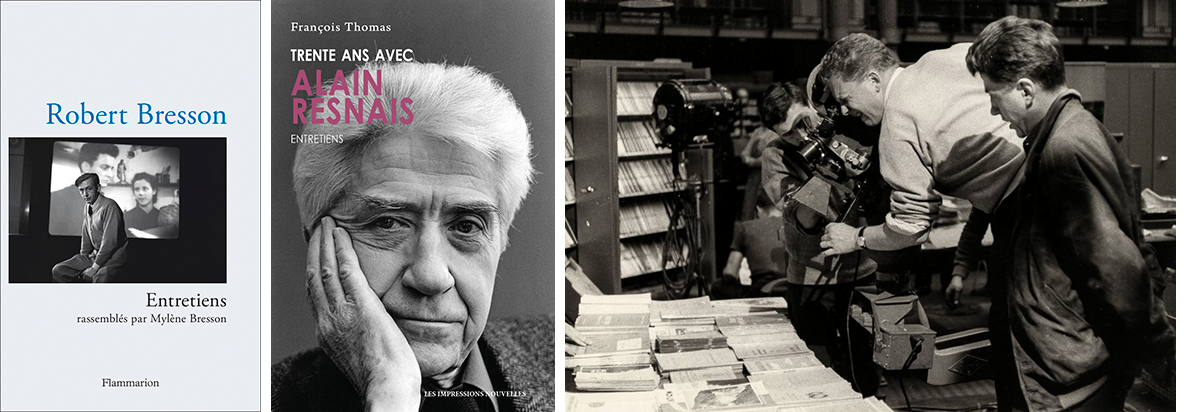
The next cluster of publications consists of four interview books. Last March, Flammarion reissued Robert Bresson: Entretiens – Rassemblés par Mylène Bresson, but slyly left out the 2013 original title “Bresson par Bresson”. An English edition of this collection has been published by New York Review Books in 2016. Also covering multiple decades of his career by way of interviews, Trente ans avec Alain Resnais: Entretiens brings together the conversations the French director had with film historian François Thomas after the release of each of his films, mainly for Positif. Gradually a friendship was born. Thomas already realized two books on Resnais' working methods and a 1997 documentary. This new collection was published last month by Les Editions Nouvelles.
Note that the same François Thomas is also directing the online publication series of the Resnais Papers. Resnais would have turned 100 on June 3. The Imec, which preserves his archives, pays tribute to him all year long: every Thursday, François Thomas invites a personality to comment on an unpublished discovery taken from the archive. With 52 planned episodes, the collection is already getting quite rich with contributions by among others Serge Toubiana, Suzanne Liandrat-Guigues, Dominique Païni, Michel Ciment and Thomas himself with an entry about Resnais' storage methods, putting everything in labelled suitcases at the end of each of his projects. Together they constitute a archival portrait of a life of cinema.
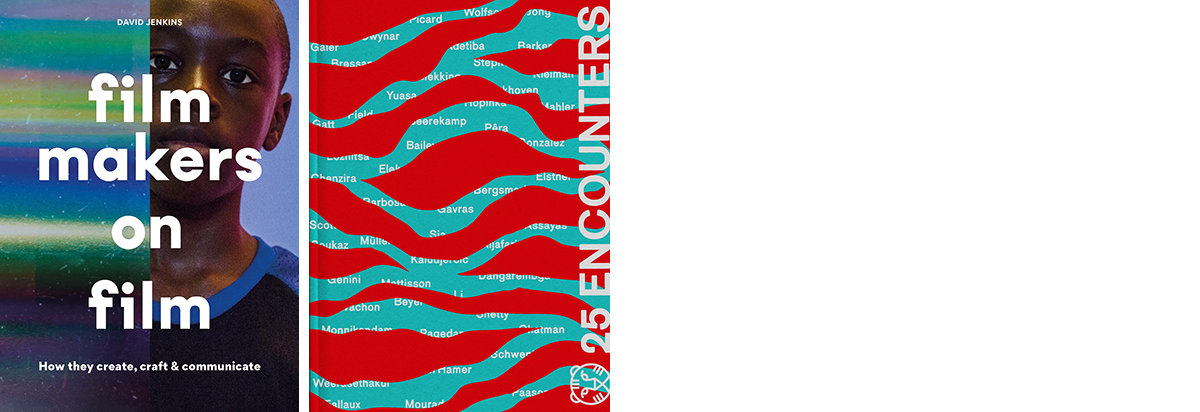
In Filmmakers on Film, editor of Little White Lies magazine David Jenkins chose 50 directors and aims to show in a concise 128 pages how they developed their distinctive visual styles and the core ideas that underpin their practice. He does so trough a curated selection of quotations, images and interviews, including new conversations with Pedro Costa and Apichatpong Weerasethakul, among others.
The latter's also part of the, not 50 but 51, filmmakers and other guests that the International Film Festival Rotterdam invited for their special 50th anniversary print publication. Artists, journalists, activists and scholars were paired in 25 conversations in which they share their thoughts, expectations and experiences on film, film festivals and the arts in general. This collection of no less than 320 pages is the eventual result of what was initially conceived of as a series of live conversations with film screenings. Every duo also chose a film together and every encounter has been moderated by an IFFR programmer or other representative of the festival. For example, Olaf Möller moderated a talk between Olivier Assays and long-time Éric Rohmer editor Mary Stephen about Rohmer’s legacy. A concept by programmer Gerwin Tamsma, 25 Encounters can be ordered via IFFR's webshop, where you can also find the full list of conversation partners between the images.
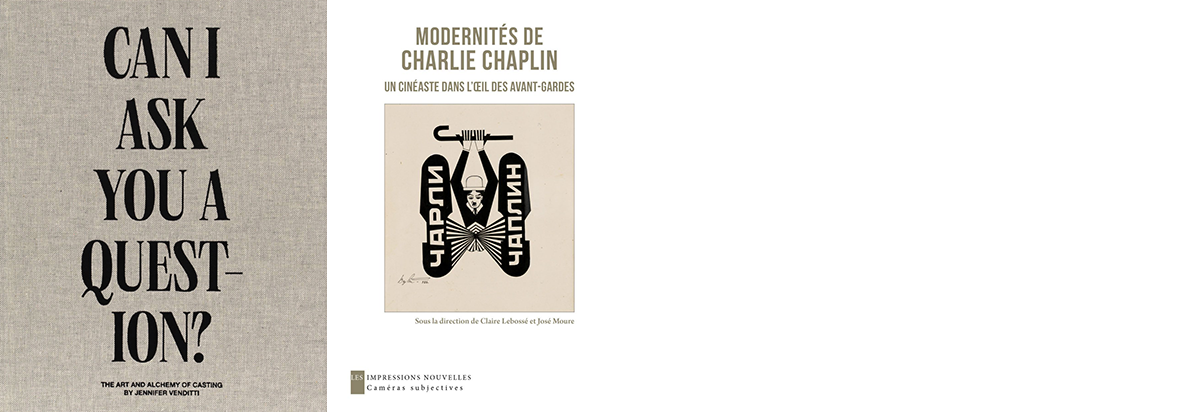
Can I Ask You A Question? The Art and Alchemy of Casting offers a thorough exploration into the uncommon process of renowned casting director Jennifer Venditti. She brought real life to films and series such as Good Time (2017), Uncut Gems (2019) and Euphoria (2019 – ), by relying on chance encounters with random strangers who capture her imagination, usually approaching them with a simple opener: “Can I ask you a question?”. One of her rules of thumb: “The person that wants to be found, in my experience, is never who I want to find.” The New York Times described this collection as, “really a visual diary of how to see people: casting photos teeming with asymmetrical faces, assorted body postures, bold sartorial choices made far from fashion runways.” Published last month by A24, the book contains over 300 pages of original casting photos, writing by Venditti, plus interviews and contributions from collaborators including photographer Alec Soth and director Josh Safdie, who stated: “All these audition tapes she does, I believe they are a form of filmmaking.”
An actor and screen presence that never ceased to fascinate, Charlie Chaplin not only captured the imagination of international film audiences but very quickly also that of avant-garde artists, writers and intellectuals – from Louis Aragon to Walter Benjamin, from Robert Desnos to Alexandre Rodtchenko, from Fernand Léger to Sergei Eisenstein or from Henri Michaux to Pablo Picasso. Modernités de Charlie Chaplin: Un cinéaste dans l'œil des avant-gardes explores these elective affinities between the modernity of Chaplin and that of the avant-garde art of its time where he became a model and an iconographic and literary subject. Published last month by the Brussels publishing house Les Editions Nouvelles, the book is co-edited by Claire Lebossé who was the co-director of the homonymous exhibition at the Fine Arts Museum of Nantes and who coordinated its 2019 catalogue issued by Editions Snoeck based in Ghent, Belgium.
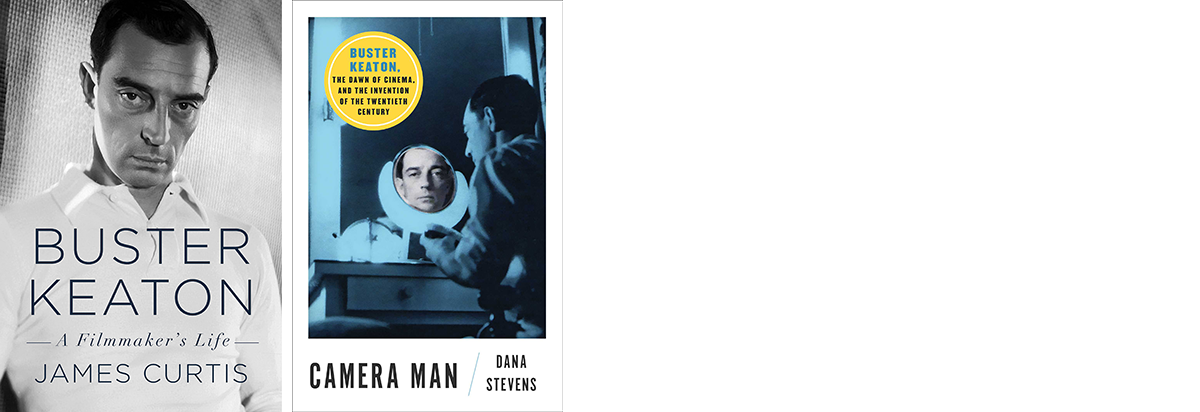
In her first book, Slate’s film critic Dana Stevens also offers a wide-ranging meditation on modernity but trough a complex portrait of Chaplin’s eternal counterpart, the one-of-a-kind artist Buster Keaton. Camera Man: Buster Keaton, the Dawn of Cinema, and the Invention of the Twentieth Centuryis far more than a work of film history or a biography. A landmark version of the latter approach, received in many reviews as definitive, appeared almost simultaneously at the beginning of this year with Buster Keaton: A Filmmaker's Life by acclaimed film historian and Hollywood biographer James Curtis.
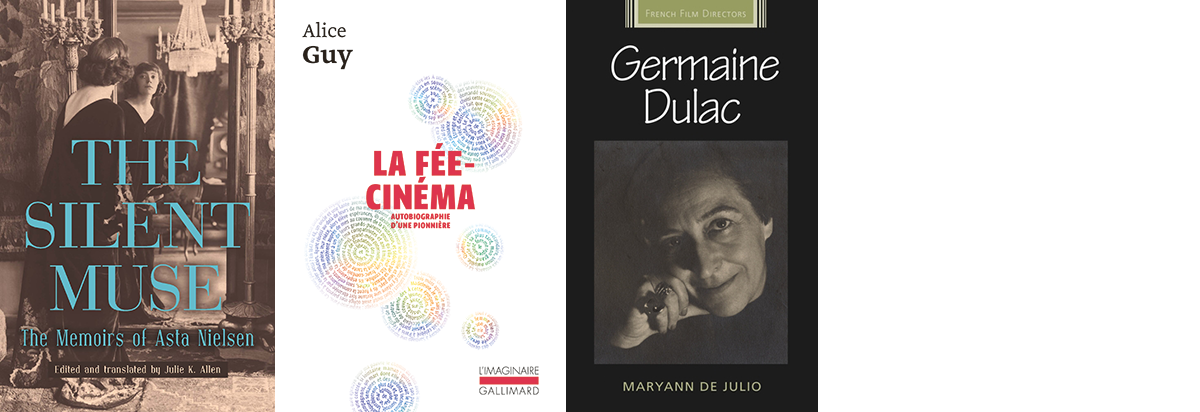
A contemporary of Keaton and Chaplin and a global star without parallel in the silent era, Asta Nielsen published her memoirs in two volumes in 1945-46, expanding on earlier writings. Although they have appeared in multiple Danish, German, and Russian editions, the memoirs have surprisingly never been published in English until now. The Silent Muse: The Memoirs of Asta Nielsen offers eyewitness insights into early European film, her impoverished childhood, her star persona and the price of fame, among other subjects. Nielsen’s charisma and fame were without parallel. As Belgian Dirk Lauwaert wrote in an ode to the Danish actrice: “Opponents petrify and swerve to avoid being burnt, losing their posture at the sight of so much excess. The story evaporates like boiling water in a cauldron. Unpleasant, indeed frightening. A retort? That is impossible!” Published last month by Camden House, the memoirs have been translated, introduced and annotated by Julie K. Allen.
The memoirs of a fellow female pioneer of Asta Nielsen but then behind the camera, Alice Guy-Blaché, have been reissued in French and English. The world’s first women filmmaker died in 1968 and her memoirs, although completed in 1953, were not published until 1976 (Paris: Denoel/Gonthier). Ten years later, they were translated for the first English-language edition (Scarecrow Press) by Anthony Slide, who now also edited the 2022 edition, The Memoirs of Alice Guy Blaché, for Rowman & Littlefield and wrote a new foreword. Long erased from history, Alice Guy writes with precision of her beginnings in the motion picture industry, the magic of accidents, her direction not only of silent films but also some of the earliest synchronized sound motion pictures, her marriage and journey to the United States, the founding of her own studio in New Jersey, her fame, and the sad journey into obscurity in the 1920s. Forthcoming with Gallimard this month, the French edition, La Fée-Cinéma. Autobiographie d’une pionnière,has been pimped with a foreword by Celine Sciamma. July next year, we celebrate Alice Guy's 150th birthday.
The contributions of Alice Guy-Blaché are contrasted with those of another female film pioneer, Germaine Dulac, in the concluding chapter of a new monograph on the latter in Manchester University Press' ‘French Film Directors Series’. Germaine Dulac draws on a wealth of archival material – both films and writing – to study Dulac’s “behind the scenes” work on filmmaking and her social/political activism in the field of cinema. The biographical and historical introduction contextualises Dulac's position at the heart of the avant-garde. Last week, the Cinémathèque française opened a retrospective of her work running until the end of this month.
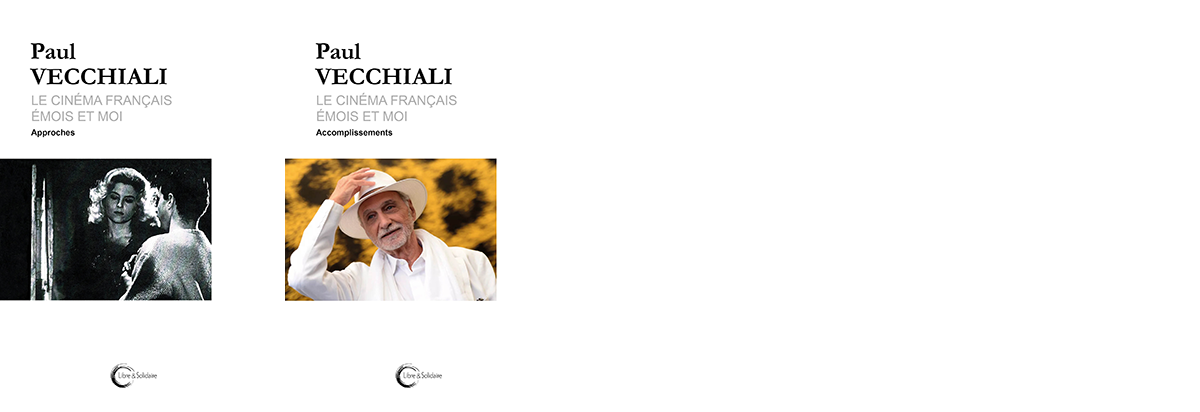
We conclude the memoirs section with the two-volume autobiography of French director, producer and writer Paul Vecchiali, Le cinéma français, émois et moi, announced for the end of this month by publisher Libre & Solidaire. The first tome Approches deals with Vecchiali’s youth in Toulon, his Corsican origins, and his beginnings in cinema... “I have crossed so many milieus, undergone so many so-called historical events that to neglect some of them would have distorted the understanding of my career. Honest as my memory allows, I have plunged into this tumultuous river, often fearing to drown in it; taking this risk to remain as close as possible to my truths. Don't be surprised by the title chosen, the following pages will confirm it, I was ‘in the cinema’ from childhood, learning the secrets of life through films and those of love through my characters, thus the actors. Until the end of the road or, to use the parable of the river, until the ‘sea’, I will have been faithful to my passion, an assiduous spectator and responsible filmmaker.” The second volume Accomplissements is devoted to his numerous films: a career that continues since, at 91, Paul Vecchiali is still making films, the latest of which, Pas de quartier, has not yet been released in cinemas.
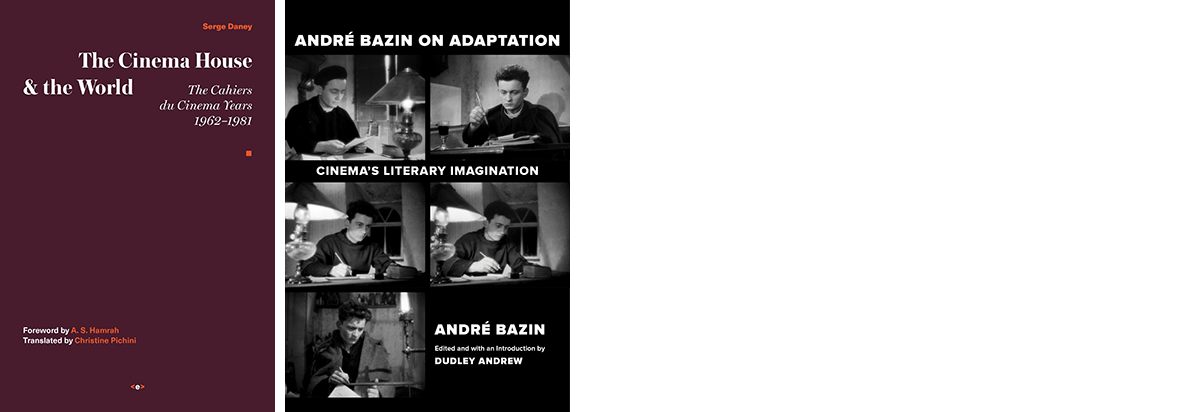
Paul Vecchiali wrote for Cahiers du Cinéma in the 50s and 60s. Critic Serge Daney, with whom Vecchiali’s co-member of the production collective Diagonale, Jean-Claude Biette co-founded film magazine Trafic, once described Vecchiali in a tv show in 1980 as, “the best French producer. Not only are all his films ‘pretty good’ but what he does is to take material and work on it, refine it. Diagonale manages to do what French cinema has never done before: working over pre-existent materials. They have the desire not only to cite old cinema – interwar francophone cinema – but to make it anew, but better.” We'll still have to wait a bit for the English translation of Daney’s texts for Trafic, but the long-anticipated translation of the collection of his writings for Cahiers is now available for pre-order before the actual release in September. Originally published by Editions P.O.L in 2001, The Cinema House and the World: The Cahiers du Cinema Years, 1962–1981 has been translated by Christine Pichini for publishing house Semiotext(e) and includes a foreword by critic A.S. Hamrah. On June 12, it has been 30 years since Daney passed away. To honour his memory, Sabzian has published three articles on Daney that week.
Serge Daney still reviewed Dudley Andrew’s biography of Cahiers' co-founder André Bazin in Libération in 1983. “Andrew's book let us glimpse, through the cracks of the intellectual itinerary, a man. A man who stuttered, loved animals, has a sense of humor, and knew how to share his passion,” he wrote. Bazin expert Dudley Andrew has now edited and introduced a new collection of Bazin’s writings on literary adaptations, out since February with University of California Press. Adaptation was central to André Bazin’s lifelong query: What is cinema? Placing films alongside literature allowed him to identify the aesthetic and sociological distinctiveness of each medium. More importantly, it helped him wage his campaign for a modern conception of cinema, one that owed a great deal to developments in the novel. Including pieces on adaptations of Conrad, Hemingway, Steinbeck, Colette, Sagan, Duras, Bronte, Melville, Tolstoy, Balzac, Hugo, Zola, Stendhal and more, André Bazin on Adaptation: Cinema's Literary Imagination contains previously unavailable esssays, now ready to be discovered for the first time in English. Jonathan Rosanbaum called this collection, “a veritable bounty, and Dudley Andrew is the ideal person to bring it to us.”
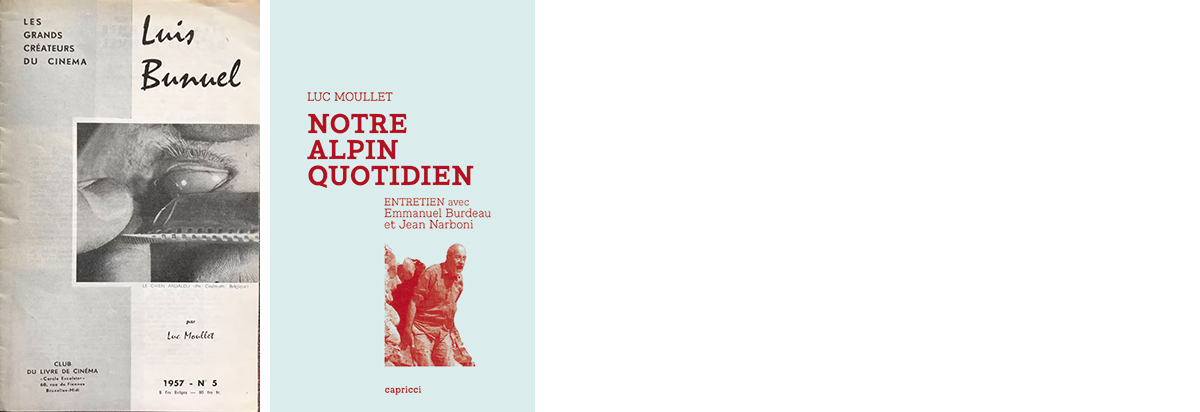
A last report on a member of the former Cahiers clique: ever-present in our book wraps over the last years, Srikanth Srinivasan has not one but two new installments in his vast Luc Moullet translation project, one finished and one in the works. The first is a translation of the short monograph which Moullet wrote at the age of only 19, Luis Buñuel (1957) – the fifth and rare volume in the series Les Grands Créateurs du Cinéma, published bimonthly by the Club du Livre de Cinéma in Brussels. Srinivasan clarifies how Moullet was shooting on two fronts in this special text. He was, on one hand, valorizing a filmmaker who was not exactly a favourite at Cahiers, where Moullet, in his own words, had only a standing place at that point. On the other hand, he is trying to “rescue” Buñuel from the old guard of Positif. Srinivasan suggests that the fact that the text was published in Brussels helped Moullet pose this double challenge.
The second, ongoing translation concerns Notre alpin quotidien (Capricci, 2009), the “candid, insightful and very funny book” in which former Cahiers chiefs Emmanuel Burdeau and Jean Narboni interviewed Luc Moullet at length. How to sell a film on its title, how to soften Jean-Luc Godard, why the beard, where does his comedy come from, where does his documentary method come from, what budgets, what recipes... The translation includes the central part of the book, Moullet’s “explosive” filmmakers manual with about fifty points, from lighting to editing, from writing to actors etc.
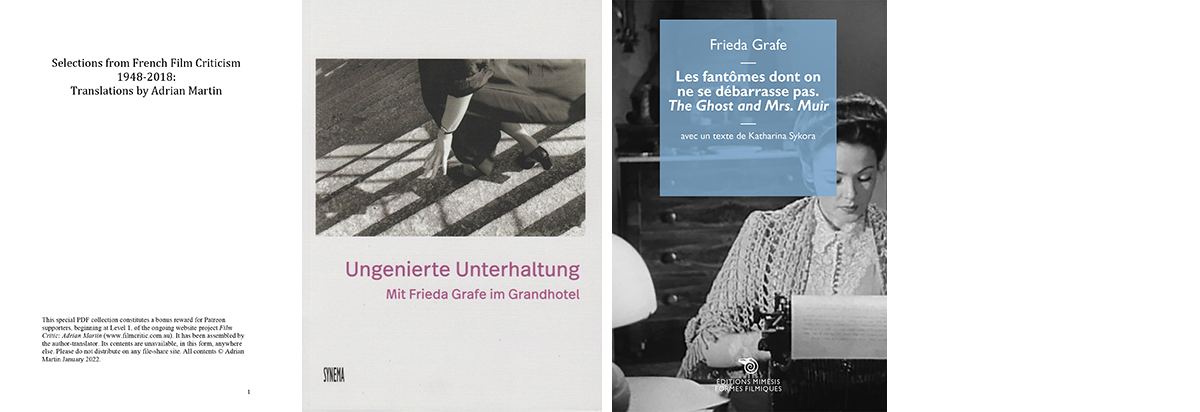
Another English translation of an essay by Luc Moullet, one he wrote on Catherine Breillat in 1992 for Trafic, has been made available by critic Adrian Martin. It's part of Selections from French Film Criticism 1948-2018, a special bonus PDF accessible to Patreons of his website whose support begins at Tier 1 ($5). “It is a 95-page collection of essays from the annals of French film criticism & theory, spanning 70 years – all translated by me over the past 20 or so years, and most either never published before anywhere, or hard to access in their printed form.” Next to Moullet, other translated authors include Michèle Firk, Roger Tailleur and Alain Masson, whose work – for one reason or another – has never made it through to English-language publication. All three are strongly identified with the French magazine Positif – “forever the neglected doppelgänger/nemesis of Cahiers du cinéma in the eyes of the global film world – from the 1950s until today”. “I have worked on [these translations] for my own pleasure and education. And may, now, they also be for yours.”
Let’s move from the French to the German tradition of film criticism with two new editions from critic and translator Frieda Grafe (1934-2002) whose writings Adrian Martin once described as “form[ing] an invaluable corridor and an infinitely rich transitional world.”. In 1990, Grafe wrote the essay ‘Die saubere Architektur in Gefahr. Die Grandhotels in der Unterhaltungsindustrie. Mit: Filmhistorischer Hotelführer’ in which she argues that the grand hotel film is its own unique genre in which cinema reflects on itself with its backstage corridors, comedy, unexpected encounters, easy conversation and, last but not least, film festivals – an invention of the spa industry. This “genre” had its heyday in Hollywood and Europe in the 1930s and 1940s with Grand Hotel (Edmund Goulding, 1932) and other films, but also had precursors in silent cinema and successors, for example, in the Nouvelle Vague. Like cinema, Frieda Grafe saw the grand hotel as a transformative space. Not a site of identification, but the promise of deferred identities, commingling, and permeability: socially, morally, and financially. The latest volume in the SYNEMA-Publikationen series, Ungenierte Unterhaltung: Mit Frieda Grafe im Grandhotel contains the complete version of Grafe’s long essay, as well as her film historical hotel guide. The publication is a joint effort of the Kinothek Asta Nielsen e.V. in Frankfurt/Main and the Seminar für Medienwissenschaft in Basel, and was edited by Karola Gramann, Ute Holl and Heide Schlüpmann. Other authors in this German-language collection reflect on and vary on Grafe’s text, her writing itself or one or the other Grand Hotel film. Eric de Kuyper’s original contribution to the book, ‘Pour Frieda / Für Frieda’ was translated on Sabzian in English and Dutch.
Also last April, Frieda Grafe’s analysis of Joseph L. Mankiewicz's The Ghost and Mrs. Muir (1947) has been translated into French as Les fantômes dont on ne se débarrasse pas. – The Ghost and Mrs. Muir. Grafe wrote the monograph on this film for the BFI Classic series in 1995. In Grafe’s text, there is no ghost, but a masculine double imagined by Mrs. Muir. Published by Editions Mimésis in their series, ‘Formes filmiques’, the French edition is accompanied by a text by art historian and curator Katharina Sykora.
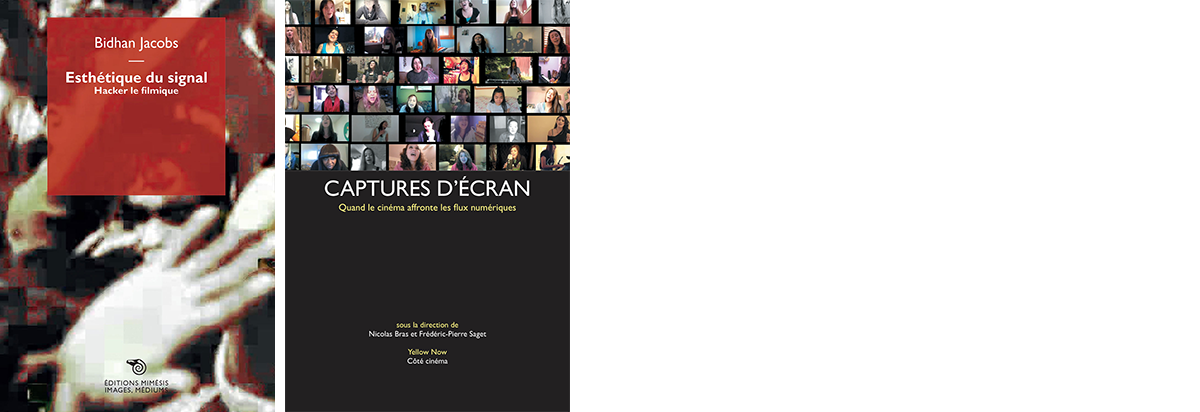
Issued by the same publisher, Mimésis, is a book of which Nicole Brenez announced: “one doesn’t have to be a diviner to predict that the greatest book of 2022 is Bidhan Jacob’s long-awaited Aesthetics of the signal/Esthétique du signal, to be published in February, fruit of almost 20 years of research, a true event.” (The work is based on Jacob’s 2014 PhD dissertation under Brenez's supervision, and they often publish together.) Esthétique du signal: Hacker le filmique studies the lines of force of a spontaneous and collective current of artists from all over the world who discover the internal operations of machines, learn their language and enrich a technical arsenal capable of seizing the film signal.
Captures d'écran: Quand le cinéma affronte les flux numériques is another book that aims to lay bare the logic of digital flows by using, precisely, these flows themselves as a formal and narrative base. It addresses both fiction that takes place on a computer screen and works that reuse images available online, from YouTube to surveillance cameras and Google Maps. Together, these films draw a screenshot aesthetic: a way for cinema to respond to online images by appropriating them. Including contributions by specialists, roundtable conversations, interviews and a filmography, the publication is edited by Nicolas Bras and Frédéric-Pierre Saget, film programmers at the Brussels Cinema Nova, where the idea for this publication was born, where it eventually was launched on May 12, and where they are running an accompanying program of screenings called ‘Screenshot’ until June 26. Published by Yellow Now, the book is also for sale at the bar in Nova.
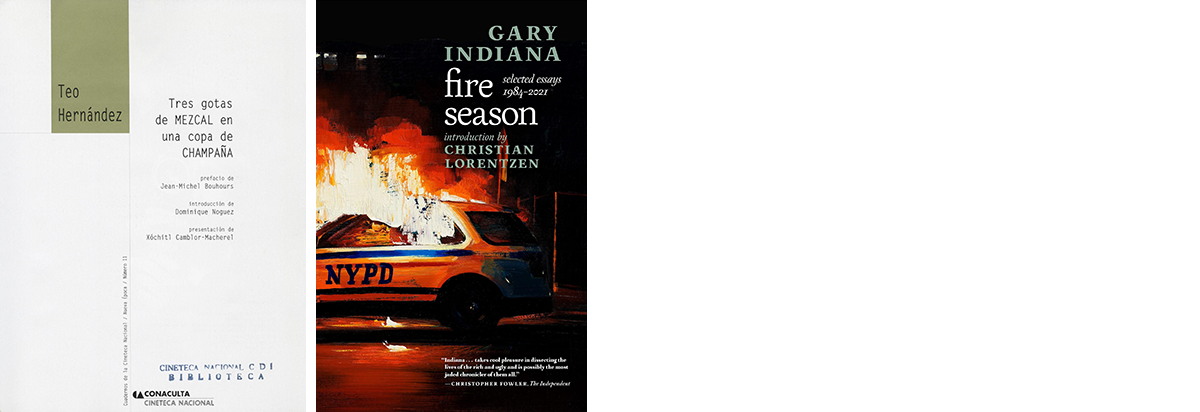
Let’s begin a next cluster of publications dealing with avant-garde cinema with a note that the Spanish-language journals of the Mexico-born Super 8 filmmaker Teo Hernández have been made accessible in a crisp scan by the Hernández Twitter account @gododivine. This clean copy is a huge upgrade from the illegible autocorrected version that was previously floating around. Based on the French-language 1997 Centre Pompidou edition, the 1999 Spanish version that was limited to 500 physical copies has become impossible to buy or borrow. Hernández (1939-1992) lived and worked in Paris from the late 1960s through the early 1990s. Introduced by Dominique Noguez and preceded by other analytical texts, Tres gotas de mezcal en una copa de champaña brings together some of the artist’s diaries, which he sometimes wrote in French, sometimes in Spanish. Hernández meticulously exposes the genesis of his films, his moods, his travels, his loves, his projects as well as his poems and his reflections on cinema.
Published last April, Fire Season: Selected Essays, 1984–2021 is a new collection of 39 essays from novelist, cultural critic, and indie icon Gary Indiana, called one of "the most brilliant critics writing in America today" by the London Review of Books. Spanning almost forty years of criticism, Fire Season gathers many of Indiana's best writing on film, literature, politics, high art or pop culture, such as the work of Robert Bresson, Andy Warhol, Barbet Schroeder, Daniel Schmid, Tracy Emin or Barbara Kruger. You can read an excerpt from his text, “The Sadean Cinema”, on Pasolini's Salò (1975) on the website of Metrograph.
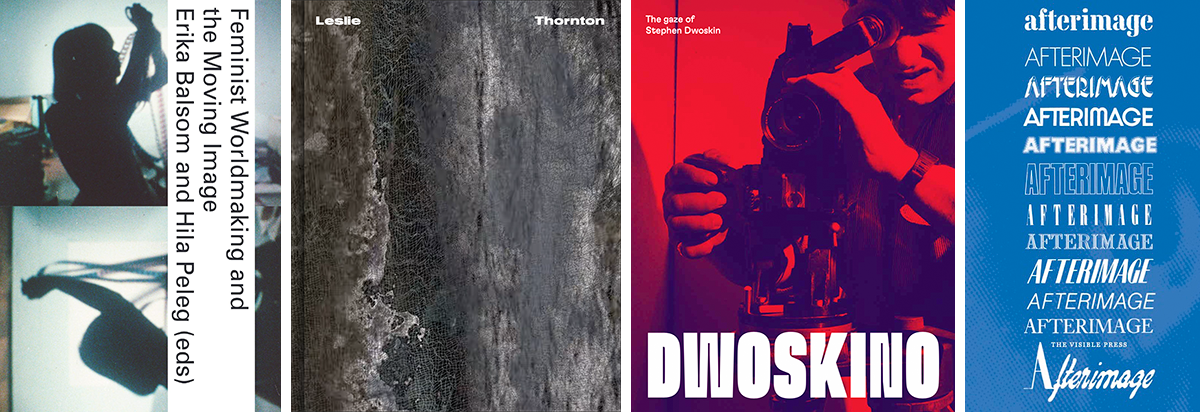
Forthcoming in August with MIT Press, Feminist Worldmaking and the Moving Image revisits major figures, contexts and debates on nonfiction filmmaking by women whose work forms a way of not only picturing the world but remaking it. Concentrating on the period between the 1970s and 1990s, the book offers ten original texts, two conversations and eight short essays composed in response to historical texts written by filmmakers. The historical texts, half of which are published in English for the first time, appear alongside the essays. The publication accompanies the monumental exhibition ‘No Master Territories’ featuring an impressive constellation of no less than 90 artists and filmmakers (too much to mention). Years in the making, the exhibition and screening series just opened last weekend and run until August 28 at Haus der Kulturen der Welt (HKW) in Berlin.
Erika Balsom who edited and curated the latter publication and exhibition together with Hila Peleg also contributed to the first monograph on American avant-garde filmmaker and artist Leslie Thornton, whose work is included in the Berlin expo as well. A richly illustrated volume published by Sternberg Press, Leslie Thornton further includes contributions by Su Friedrich and Chris Kraus, among others. Since the mid-1970s, Thornton weaves together her own footage and voice with archival film and audio. Her work consistently interrogates modes of representation and the violence of looking, pushing beyond critiques of the gaze to consider biases in perception, or the way voice and sound can undermine an otherwise dominant visual narrative.
Also closely connected to the gaze theory, the work of Stephen Dwoskin “opened a completely new perspective on cinematic voyeurism for me,” Laura Mulvey once declared. Especially his early work, such as Dyn Amo (1972), interrogated power relations through the camera and revelead cruelty and violence. DWOSKINO: The Gaze of Stephen Dwoskin is the culmination of a three year research project, ‘The Legacies of Stephen Dwoskin’, at the University of Reading where his archive is housed. Published by LUX, the book is a unique visual distillation of Dwoskin’s life and times, with hundreds of never-seen-before images taken from his archive, and texts by among others Laura Mulvey, Raymond Bellour, Raymond Durgnat, and Dwoskin himself.
Stephen Dwoskin’s text on David Larcher’s 2,5 hour epic of the postwar British avant-garde, Mare’s Tail (1969), is one of many articles from the independent British film journal Afterimage (1970-1987) that are now gathered in The Afterimage Reader. “One of those precious magazines through which the great wind of history blows, one of those rare magazines that made history,” as Nicole Brenez phrases it. Published last month by The Visible Press and edited and introduced by Mark Webber, this collection includes texts by scholars Noël Burch and Peter Wollen, filmmakers Jean Epstein, Jean-Luc Godard and Derek Jarman, new contributions from two of the journal’s editors, Simon Field and Ian Christie, plus extended interviews with Hollis Frampton and Raúl Ruiz, and more.
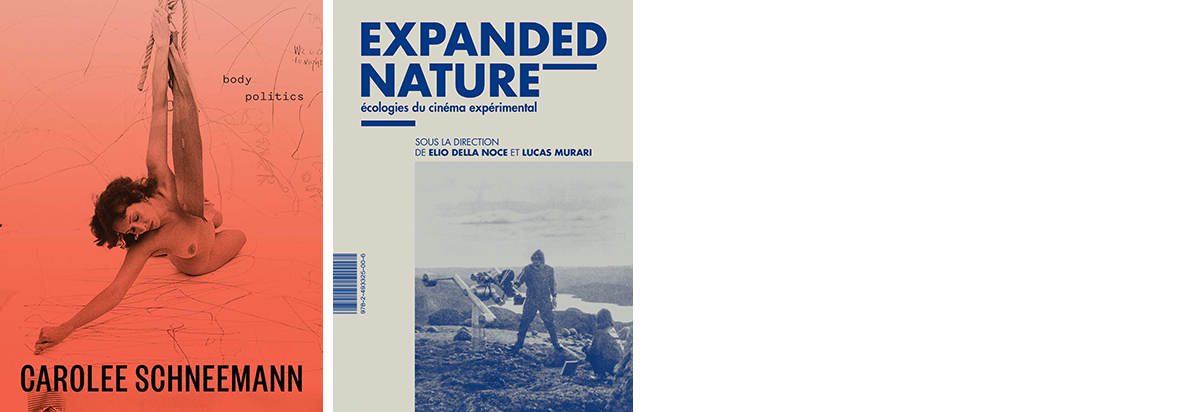
Stephen Dwoskin crossed paths with the American artist Carolee Schneemann (1939-2019), who starred in his debut feature Time For (1970), and from the mid-1970s, Dwoskin would also focus his camera upon his own body, afflicted by polio during childhood, in such films as Behindert (1974) and Outside In (1981). Carolee Schneemann: Body Politics traces six decades of Schneemann’s diverse, transgressive and interdisciplinary work, including writings on her pioneering films such as Fuses (1967), in which she forged a new experimental language, exploring sexual desire, challenging the male gaze and taking her daily life and relationships as source material. Containing contributions by Elena Gorfinkel and Eileen Myles among others, this publication will appear in September with Yale University Press to accompany the major survey exhibition of Schneemann’s work at the Barbican in London coming up this fall.
Carolee Schneemann conceived her landmark film Fuses (1967), in which she has sex with her partner, as shot through the eyes of her cat. Schneemann spent some three years marking on the film, baking it in the oven, even hanging it out the window during rainstorms on the off chance it might be struck by lightning. A new anthology published by Light Cone, Expanded Nature – Écologies du cinéma expérimental, explores such practices and questions: how do filmmakers and collectives form communities with other non-human beings to deconstruct human privilege, and how can they allow the camera to be affected by natural forces, engaging one's own filming body in a symbiotic relationship with the environment? These are some of the ecologies of experimental cinema presented in this book, contributing to the restoration of our sensory bond with the natural world. Investigating a different history of cinema, this French-language collection includes texts by Scott MacDonald, Kim Knowles, Rose Lowder, Bidhan Jacobs and Jacques Perconte, among others.
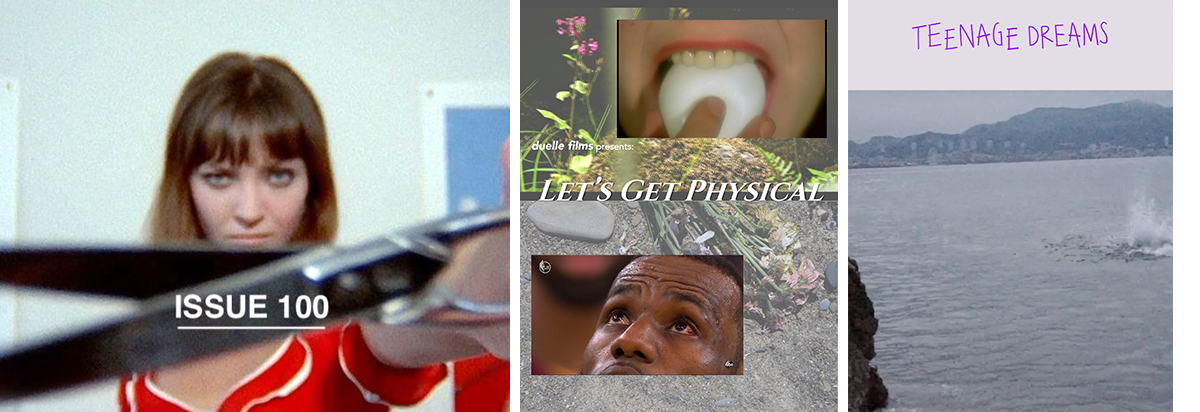
As usual, we conclude with our section on newly-founded film magazines or special issues. Last January, Senses of Cinema celebrated its 100th issue with a centerpiece dossier on Jean-Luc Godard and the launch of a new section ‘Great Actors’ on the art and craft of acting. This centennial edition also marked a change in the editorial board. Both Michelle Carey and Daniel Fairfax bid the magazine farewell while Abel Muñoz Hénonin and Tara Judah were welcomed as new editors. The latter also joined Screen International as an editor that same month.
Already up to issue 5 but not yet on our radar at the time of our previous book wrap last winter, NYC-based artists and writers Gina Telaroli and Carolyn Funk launched Duelle last September. This new online magazine features one larger piece of film criticism from both Telaroli and Funk, as well as snapshot reviews and photo essays connecting cinema to the outer world. It comes as a downloadable PDF publication that can be printed and saved. Part of their Patreon, the magazine is one of the ways to generate funding for their new homonymous production company and in turn create films and form a community. Issue #1 is free to read and download.
Last January, Luise Mörke, participant of the Young Critics Workshop at Film Fest Ghent last year, launched another online zine called Teenage Dreams, a cornucopia of short fiction, music, film, drawings and poetry. Edited and assembled by Mörke, the first issue’s thirteen different approaches reckon with the transitional moments between childhood and adult life, a time when a surplus of dreams went hand-in-hand with parental care, supervision and the regulated routine of school days. They invoke nostalgia and discomforts, unveil delusions or forage for the aesthetics of the early 2000s in the here and now. The contributors include Maximilien Luc Proctor and Tobias Rosen, among others.
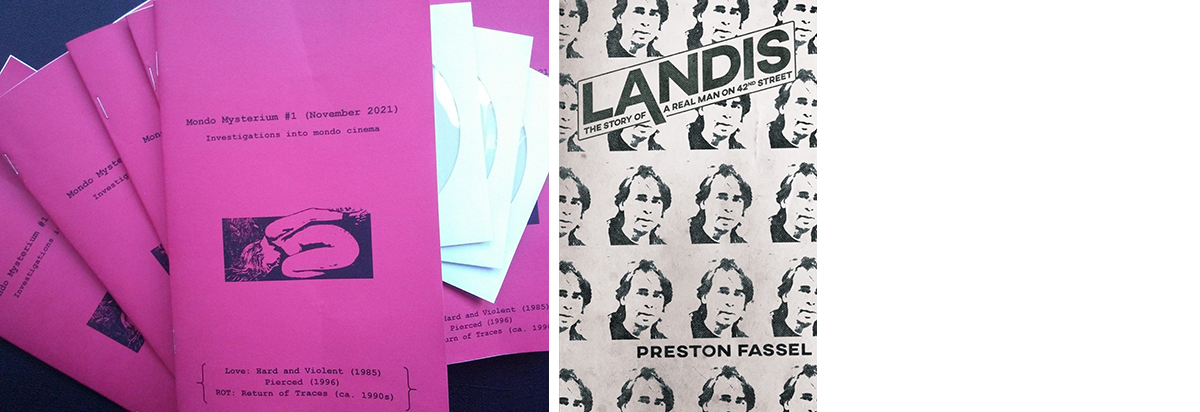
More film zines, physical copies in this case, with the creation of Mondo Mysterium: Investigations into Mondo Cinema. A first and a second issue has appeared in November and December last year. Part of a $25 subscription, the essays in this video zine accompany three included discs with copies of rare mondos that have never had a DVD release (of the particular versions included), like the Return Of Traces 1990s partial workprint or the longer English print of Love: Hard and Violent (1985) included with the first issue. Issues could (or can) be ordered via specialist and founder Al Rogers on Messenger or Instagram (@themondomaniac). A next issue is in the making, but with some changes: the zine will no longer be coming out monthly, but more sporadically as it will be expanding to now include not only three films and pieces about them, but additional articles, interviews, profiles and other content as well. Two new features will be added: a Letters section with questions or mondo musings you want printed in the next issue, and a Classifieds section where readers can submit a listing for any mondo or shocku-related wares they’re either looking for, or looking to get rid of.
On a side note, the full story of the creator of seminal fanzine Sleazoid Express and exploitation film expert, Bill Landis, has now been pieced together for the first time in Landis: The Story of a Real Man on 42nd Street. His Sleazoid Express (1980-85, 1999-2005) was one part film magazine and one part anthropological study, the only one to seriously critique the grindhouse movies that played the theaters of NYC's 42nd Street while also documenting the whole subculture around the place. Preston Fassel wrote the first ever biography of this fascinating figure, largely forgotten by the mainstream – from his turbulent childhood, to his meteoric rise in the New York vice scene, to his tragic demise on the streets of Chicago.
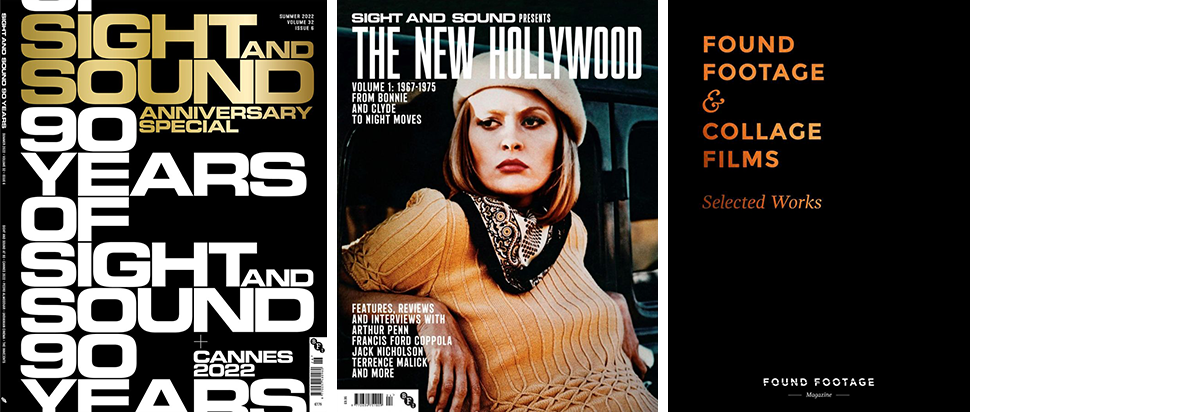
Whereas Senses of Cinema reached its 100th issue, Sight and Sound magazine celebrates its 90th anniversary this month with a special 164-page summer issue that looks back through the archives. Last March, critic Geoff Andrew already edited an anthology in print for Sight and Sound. Following previous specials (‘bookazines’) on Godard, Scorsese and Spike Lee, The New Hollywood, Volume 1: 1967-1975 – From Bonnie and Clyde to Night Moves includes writings from the time these movies were made, including pieces by Tag Gallagher, Jonathan Rosenbaum, James Monaco and Tom Milne, among others. A second volume is being prepared.
Another book published by a magazine, Found Footage & Collage Films: Selected Works provides a vivid account of the aesthetics and contexts of found footage filmmaking in contemporary moving image culture. Published by Found Footage Magazine, this edition comes as a DVD+Blu-ray boxset with 16 short films, while the accompanying 96-page book is filled with analysis and insights of the selected films. You can find who wrote an essay on which film on the website under ‘Films’. Contributors include Scott MacDonald (on Yervant Gianikian & Angela Ricci Lucchi), André Habib (on Bill Morrison), Catherine Russell (on Peggy Ahwesh) and Ela Bittencourt (on Eve Heller), among others.
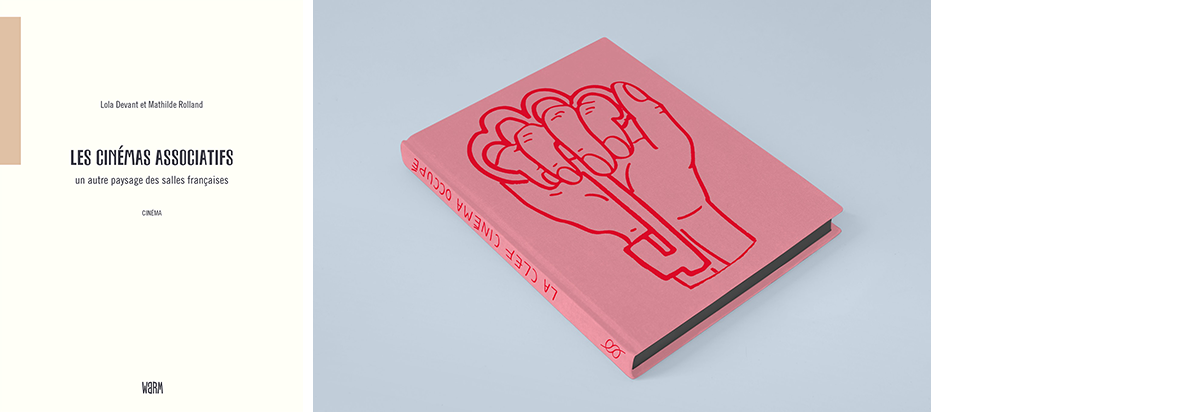
While recent or forthcoming books deal with the construction and history of the Parisian Grand Rex cinema or with the Quartier Latin in cinema, we'd like to single out and conclude with a publication on the cinémas associatifs in France and one of them, in the heart of the same Latin Quarter, in particular. A cinéma associatif (or community cinema) is run by a team of volunteers. Almost one third of the cinemas in France operate like this. Based on this observation, Lola Devant and Mathilde Rolland undertook a tour of the country, including more remote or rural areas, to meet a hundred people involved. Published by WARM, Les cinémas associatifs, un autre paysage des salles françaises offers some of these interviews, accounting for the singularity of approaches, realities and territorial dynamics.
Published almost simultaneously this mid-June, La Clef, cinéma occupé is a look back at nineteen months of occupation of the last cinéma associatif in Paris. After two and a half years of resistance, however, the collective occupying La Clef was evicted on March 1 this year. The building is now for sale, and anyone can help to buy it back by making a donation here.
More reading inspiration can be found in our newly-launched, trilingual section Passage in which we invite film critics, authors, filmmakers and spectators to present a text or fragment on cinema that left a lasting impression. It can be a phrase, a paragraph, a sentence, a passage, a formulation, an essay or an interview that at some point disrupted, shifted, confirmed or crowned their view of or thinking about cinema. Together, these contributions constitute a montage of personal reading histories and thoughts.

